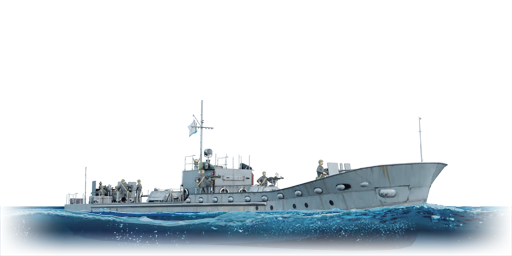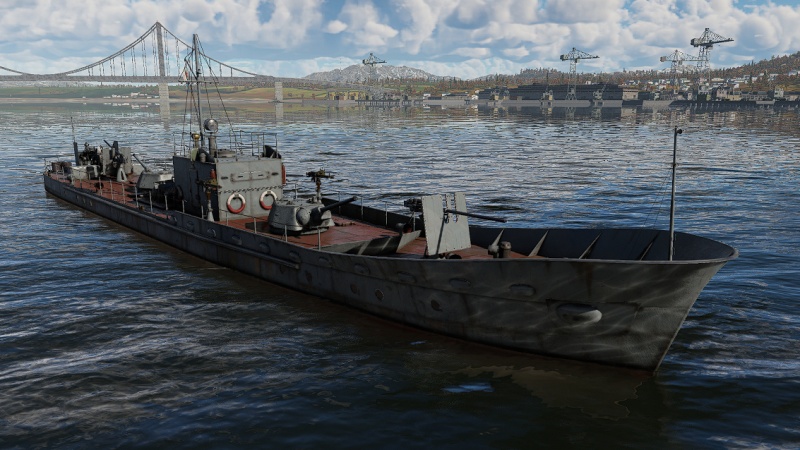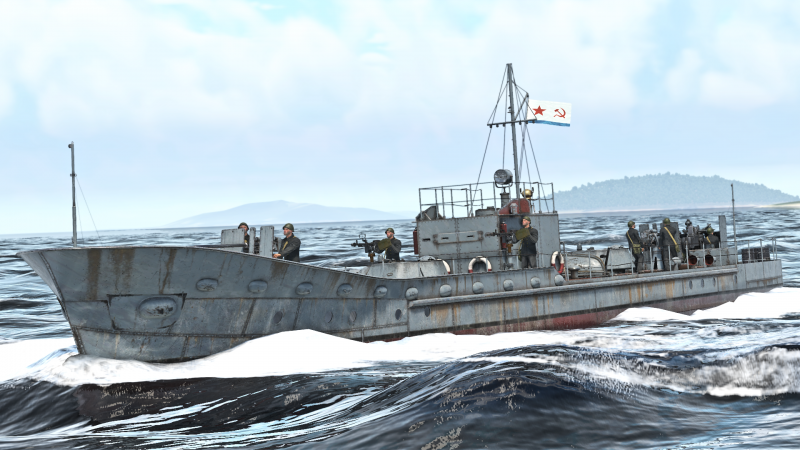MBK-161 late
| This page is about the Soviet armoured gun boat MBK-161 late. For the premium version, see MBK-161 early. |
Contents
Description
The MBK-161 late modification is a rank Soviet armoured gun boat with a battle rating of (AB), (RB), and (SB). It was introduced during Update 1.79 "Project X" when the Soviet fleet was implemented into the game.
General info
Survivability and armour
The MBK-161 late, as an armoured boat, has decent survivability against light arms fire. The ship has 39 crew members, most of which are split between the three armoured compartments. The engines, fuel tanks and ammunition stowage are all located in the central armoured "citadel", thereby improving the vessel's survivability.
With that said, the MBK-161 late has great armour protection for a coastal vessel: the bow and stern have 18 mm of armour plating, while the central section has 52 mm of armour. The two main gun turrets have 53 mm of armour while the bridge has 60 mm of armour. This armour is enough to block most small-arms fire including HE shells up to 127 mm. However, the protection is not complete, as the smaller-calibre turrets are not armoured. Additionally, SAP or AP shells of 76 mm calibre or higher will likely penetrate your armour leading to damage to your internal compartments. Additionally, destroyer-calibre HE can sometimes hullbreak your ship.
Mobility
Given its significant armour protection, the MBK-161 late has terrible mobility. The ship reaches a top speed of 25 km/h in realistic mode, meaning that it will take you a significant amount time to get anywhere. The ship's turning circle, rudder shift and acceleration are all lacklustre as well.
| Mobility Characteristics | |||
|---|---|---|---|
| Game Mode | Upgrade Status | Maximum Speed (km/h) | |
| Forward | Reverse | ||
| AB | |||
| Upgraded | |||
| RB/SB | |||
| Upgraded | |||
Modifications and economy
Armament
Primary armament
The MBK-161 (1944) carries two 76 mm F-34 cannons. This gun has a decent fire rate of 16 rounds per minute. The weapon itself is decent at closer ranges but will struggle to damage destroyers or aircraft, as the weapon has a poor traverse rate and lacks HE-TF/HE-VT shells. The gun itself has access to two shells - the OF-350M high-explosive (HE) shell and the BR-350A armour-piercing shell. Of these rounds, the HE is almost always the best against enemy boats as it has the most explosive filler, and consequently, does the most damage. The APHEBC shells are rarely usable due to their low damage potential. For good measure, bring mostly HE, and a bit of AP for use against heavily armoured opponents.
| Penetration statistics | |||||||
|---|---|---|---|---|---|---|---|
| Ammunition | Type of warhead |
Penetration @ 0° Angle of Attack (mm) | |||||
| 100 m | 1,000 m | 2,000 m | 3,000 m | 4,000 m | 5,000 m | ||
| OF-350M | HE | 10 | 10 | 10 | 10 | 10 | 10 |
| BR-350A | APHEBC | 85 | 70 | 56 | 45 | 37 | 30 |
| Shell details | ||||||||||||
|---|---|---|---|---|---|---|---|---|---|---|---|---|
| Ammunition | Type of warhead |
Velocity (m/s) |
Projectile mass (kg) |
Fuse delay (m) |
Fuse sensitivity (mm) |
Explosive mass (TNT equivalent) (g) |
Ricochet | |||||
| 0% | 50% | 100% | ||||||||||
| OF-350M | HE | 680 | 6.2 | 0 | 0.1 | 621 | 79° | 80° | 81° | |||
| BR-350A | APHEBC | 665 | 6.3 | 1.6 | 4 | 150 | 48° | 63° | 71° | |||
Secondary armament
The MBK-161 also carries two 45 mm 21-KM cannons. These guns are not automatic, meaning that they function similarly to the F-34 main guns, but benefit from a higher fire rate of 30 rounds per minute. These weapons get access to three different HE shells (a standard HET, full HE, and HE with base fuse) along with an AP shell. The weapons do not have time fuse or proximity fuse shells making them unsuited for anti-aircraft defence. However, all three of the HE shells can work very well against enemy vessels.
| Penetration statistics | |||||||
|---|---|---|---|---|---|---|---|
| Ammunition | Type of warhead |
Penetration @ 0° Angle of Attack (mm) | |||||
| 100 m | 1,000 m | 2,000 m | 3,000 m | 4,000 m | 5,000 m | ||
| OR-73A HET | HE | 3 | 3 | 3 | 3 | 3 | 3 |
| O-240 HE | HE | 5 | 5 | 5 | 5 | 5 | 5 |
| BR-240 | APHE | 86 | 62 | 44 | 31 | 22 | 16 |
| F-73 | HE | 23 | 17 | 12 | 8 | 6 | 4 |
| Shell details | ||||||||||||
|---|---|---|---|---|---|---|---|---|---|---|---|---|
| Ammunition | Type of warhead |
Velocity (m/s) |
Projectile mass (kg) |
Fuse delay | Fuse sensitivity (mm) |
Explosive mass (TNT equivalent) (g) |
Ricochet | |||||
| 0% | 50% | 100% | ||||||||||
| OR-73A HET | HE | 835 | 1.41 | 0 | 0.1 | 56.98 | 79° | 80° | 81° | |||
| O-240 HE | HE | 343 | 2.14 | 0 | 0.1 | 181.72 | 79° | 80° | 81° | |||
| BR-240 | APHE | 835 | 1.42 | 1 m | 1.5 | 27.72 | 47° | 60° | 65° | |||
| F-73 | HE | 835 | 1.41 | 0.015 s | 0.1 | 113.96 | 79° | 80° | 81° | |||
Anti-aircraft armament
The MBK-161 (1944) carries a single 37 mm 70-K anti-aircraft gun. The 70-K is the standard Soviet anti-aircraft gun and serves as a reliable counterpart to the 40 mm Bofors gun used by the allied nations. This gun is extremely similar to the Bofors as it features a similar design, and fires continuously rather than needing to reload. The guns will eventually jam, but the time it takes to jam the weapons is very long so jamming is not a great issue. The weapon does not get access to belts, but the default one is very suited for ripping small ships or aircraft into shreds.
The MBK-161 (1944) also carries two single DShK machine guns for close in AA defence. The 12.7 mm DShK machine gun is a heavy machine gun, similar to the M2 Browning used by the Americans and the Vickers guns used by the British. This gun fires from a fixed 50-round magazine and will need to be reloaded after the magazine is expended. The gun itself is rather mediocre, and will struggle to hit targets reliably at ranges exceeding 1.5 km. As well, the weapon doesn't do damage particularly well, considering that it is of a lower calibre. The MBK-161 does not get access to any ammunition belt upgrades - the default one is the only belt available.
Usage in battles
The MBK-161 late is quite well-suited to holding capture points with its heavy armour and substantial armament. The boat is quite well-protected, meaning that it can soak up substantial enemy small-arms fire, though it is still vulnerable to heavier guns, rockets, or torpedoes. Its armament of two 76 mm cannons, two 45 mm cannons, a 37 mm autocannon, and two machine guns can easily take care of motor torpedo boats and small coastal vessels.
One main strategy for the MBK-161 late is to park the vessel close to a capture point, firing at and destroying any small boats attempting to capture the point. The MBK-161 is exceedingly slow, meaning that it will take a while for you to get anywhere; hence, it is best to find an ideal firing position to camp in. Try to angle the boat by ~45 degrees off of the firing direction, as this will increase the effective thickness of your armour without restricting the firing arcs of your main weapons. Keep in mind that the MBK-161's weapons are distributed throughout the length of the vessel, so approaching directly at the enemy is not advised. Fire from an angle or fully broadside to use all of the MBK-161's weapons.
The MBK-161 does also have good survivability. Most notably, a 52 mm armour plate protects the vessel's centre section between the two 76 mm turrets. However, the vessel's fore and aft sections have just 12 mm of armour. Given the game's crew loss mechanics, soaking fire in the fore and aft sections will deplete the crew in those sections, causing more crew to be moved into those sections and eventually causing the ship to be destroyed due to crew loss. To avoid this, make sure to angle the vessel in order to increase effective armour thickness and avoid prolonged engagements with enemy vessels. Avoid vessels with weapons over 76 mm in calibre, such as gunboats and destroyers, as their AP shells can penetrate your main armour plate.
There are two main types of foes to be aware of. First, high-rank MTBs, such as the PT-810, Jaguar, and Pr. 206. These vessels feature rapid-firing autocannons that will shred the MBK-161's unarmoured sections. They are also extremely fast so targeting can be more difficult. Against these vessels, land cover and ambush tactics are important. Try to get within 1 km of the vessels, then ambush them with your superior gun armament. Be aware of secondary armaments, such as torpedoes and rockets, which many high-rank MTBs carry.
More dangerous are gunboats and destroyers. Gunboats such as the USS Douglas carry automatic 76 mm cannons that provide significant firepower at longer ranges than your 45 and 37 mm cannons. Destroyers such as the USS Aylwin carry high calibre weapons that will penetrate your armour. Against the former, your main strategy is to ambush the gunboat at a distance where your 37 and 45 mm cannons are effective. This will typically be below 2 km in distance. Avoid longer engagements as their automatic 76 mm cannons provide more firepower than your two 76 mm cannons. Avoid engaging destroyers at all costs, as they outgun you significantly, and you lack any heavy weapons (i.e. torpedoes) to deal with them.
Pros and cons
Pros:
- Heavy armour can protect against everything up to 76 mm HE shells, meaning that you are very survivable against small calibre weapons
- 39 crew members are concentrated in highly armoured sections, and all vital components are located within the central "citadel"
- Extremely heavy armament for a coastal vessel
- Main guns do decent damage and are quite effective against coastal vessels
- Secondary weapons are potent against coastal ships and aircraft alike
Cons:
- Extremely poor mobility, with a low maximum speed and slow turn
- Destroyer-calibre HE shells can hullbreak the vessel, while most high-calibre SAP / AP shells can penetrate the armour
- Lacks high-power weapons like torpedoes, meaning that enemy destroyers are practically impossible-to-deal-with
- Main guns have limited firing angles due to the placement of secondary weapons
History
The MBK-161 (1944) class were the second and last 10 ships built of the MBK-161 class of riverine gunboats. Completed during 1944, they were large and heavily-armoured gunboats designed for use in littoral environments. Members of this class were intended to carry two 82 mm mortars, but were instead armed with two 45 mm cannons in lieu of them. The members of the MBK-161 class saw extensive service in the Baltic during the Second World War in fire support roles, and were eventually retired in the early 1950s.
The MBK-161 class were designed as a follow-up to the prior Pr. 1124 class, and were built accordingly - the ships had a much larger hull compared to the Pr. 1124 and improved armament. The MBK-161 also had a much larger crew complement of 39 crew members. In order to save time, the hulls of the MBK-161 class were simple in shape, and the main armament consisted of widely-available T-34 gun turrets.
The MBK-161 was designed with heavy protection in mind - the citadel, turrets and conning tower had armour of varying thicknesses from 52 to 60 mm. The bow and stern were also armoured with plating. However, this armour was detrimental to handling - despite the fitting of two 1,200 hp lend-lease Packard engines, the ship was only capable of making 13 knots (24 km/h). The armament consisted of two 76 mm F-34 guns, the same weapons as the mighty T-34 medium tank. Secondary armament consisted of a single 37 mm 70-K dual-purpose gun and three 12.7 mm DShK machine guns. The ships were intended to carry two 82 mm mortars, but this plan was changed - the 1943 MBK-161s were fitted with a 45 mm cannon in lieu of one of the mortars, while 1944 MBK-161s had both mortars removed and replaced with 45 mm cannon. As well, the 1944 MBK-161s had a much taller cutter-bow installed to improve handling in rougher seas.
In total, 20 MBK-161 boats were built, including 10 in 1943 and 10 in 1944. The 1943 members of the MBK-161 class entered service in late 1943 and served mainly in the Baltic region. They were involved in many surface actions, including the Battle of Nerva Island where Soviet small naval forces engaged two German Type 1939 torpedo boats - during this engagement, the MBK-161 boats "BK-503" and "BK-505" were damaged. Following the end of war, the MBK-161 class remained in Soviet inventories until their eventual disposal between 1949 and 1956.
Media
- Skins
See also
- Related development
External links
Paste links to sources and external resources, such as:
- topic on the official game forum;
- other literature.
| USSR boats | |
|---|---|
| Motor torpedo boats | D-3 · G-5 · G-5 (ShVAK) · Pr.123-bis · Pr.123K (A-10bis) · Pr.123K · Pr.183 |
| Motor gun boats | TKA-412 · MO-4 · OD-200 · Pr.253L · Pr.183 BM-21 · Ya-5M |
| Motor torpedo gun boats | Pr. 206 · Pr.206-M · MPK Pr.12412 · MPK Pr.12412P · MPK Pr.11451 |
| Gunboats | Groza |
| Armoured gun boats | BMO · MBK-161 early · MBK-161 late · MBK pr.186 · MBK pr.186 (MK 85) · Pr.1124 early · Pr.1124 late · Pr.1124 MLRS |
| Pr.191 · Pr.191M · Pr.1204 · Pr.1204 late | |






